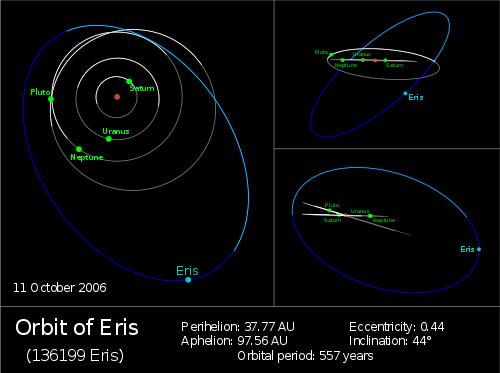
Eris, formal designation 136199 Eris, is the largest known dwarf planet in the Solar System and the ninth-largest body known to orbit the Sun directly. It is approximately 2,500 kilometres in diameter and 27% more massive than Pluto.
Eris was first identified in January 2005 by a Palomar Observatory-based team led by Mike Brown, and its identity verified later that year. It is a trans-Neptunian object (TNO) native to a region of space beyond the Kuiper belt known as the scattered disc. Eris has one moon, Dysnomia; recent observations have found no evidence of further satellites. The current distance from the Sun is 96.7 AU, roughly three times that of Pluto. With the exception of some comets the pair are the most distant known natural objects in the Solar System.
Because Eris is larger than Pluto, its discoverers and NASA initially described it as the Solar System’s tenth planet. This, along with the prospect of other similarly sized objects being discovered in the future, motivated the International Astronomical Union (IAU) to define the term planet for the first time. Under a then-new IAU definition approved on August 24, 2006, Eris is a "dwarf planet" along with Pluto, Ceres, Haumea and Makemake.
Eris is named after the Greek goddess Eris, a personification of strife and discord. The name was assigned on September 13, 2006 following an unusually long period in which it was known by the provisional designation 2003 UB313, which was granted automatically by the IAU under their naming protocols for minor planets. The regular adjectival form of Eris is Eridian.
Orbit

Eris has an orbital period of 557 years, and as of 2009 lies at 96.7 astronomical units from the Sun, almost its maximum possible distance. (Its aphelion is 97.5 AU.) Eris came to perihelion between 1698 and 1699, to aphelion around 1977, and will return to perihelion around 2256[34] to 2258. Eris and its moon are currently the most distant known objects in the Solar System apart from long-period comets and space probes. However, approximately forty known TNOs, most notably 2000 OO67 and Sedna, while currently closer to the Sun than Eris, have greater average orbital distances than Eris' semimajor axis of 67.7 AU.
The Eridian orbit is highly eccentric, and brings Eris to within 37.9 AU of the Sun, a typical perihelion for scattered objects. This is within the orbit of Pluto, but still safe from direct interaction with Neptune (29.8–30.4 AU). Pluto, on the other hand, like other plutinos, follows a less inclined and less eccentric orbit and, protected by orbital resonance, can cross Neptune’s orbit. (It is possible that Eris is in a 17:5 resonance with Neptune, though further observations will be required to know for sure.[37]) Unlike the eight planets, whose orbits all lie roughly in the same plane as the Earth's, Eris' orbit is highly inclined: It is tilted at an angle of about 44 degrees to the ecliptic. In about 800 years, Eris will be closer to the Sun than Pluto for some time.
Eris currently has an apparent magnitude of 18.7, making it bright enough to be detectable to some amateur telescopes. A 200 mm telescope with a CCD can detect Eris under favorable conditions. The reason it had not been noticed until now is because of its steep orbital inclination; most searches for large outer Solar System objects concentrate on the ecliptic plane, where most bodies are found.
Eris is now in the constellation Cetus. It was in Sculptor from 1876 until 1929 and Phoenix from roughly 1840 until 1875. In 2036 it will enter Pisces and stay there until 2065, when it will enter Aries. It will then move into the northern sky, entering Perseus in 2128 and Camelopardalis (where it will reach its northernmost declination) in 2173. Because the orbit of Eris is highly inclined, it only passes through a few constellations of the traditional Zodiac.
Size, mass, and density
The diameter of Eris has been measured to be 2,397 km, give or take 100 km, using images from the Hubble Space Telescope (HST).[38][39] The size of an object depends on its absolute magnitude and the albedo (the amount of light it reflects). At a distance of 97 AU, an object with a radius of 3,000 km would have an angular size of 40 milliarcseconds, which is directly measurable with the HST; although resolving such small objects is at the very limit of Hubble's capabilities, sophisticated image processing techniques such as deconvolution can be used to measure such angular sizes fairly accurately.)
This makes Eris only 0-8% larger than Pluto, which is about 2,306 km across. It also indicates an albedo of 0.86, higher than any other large body in the Solar System other than Enceladus. It is speculated that the high albedo is due to the surface ices being replenished due to temperature fluctuations as Eris' eccentric orbit takes it closer and farther from the Sun.
In 2007, a series of observations of the largest trans-Neptunian objects with the Spitzer Space Telescope gave an estimate of Eris's diameter of 2,600 (+400; -200) km.[8] The Spitzer and Hubble estimates overlap in the range of 2,400-2,500 km, 4-8% larger than Pluto.
The mass of Eris can be calculated with much greater precision. Based on the currently accepted value for Dysnomia's period, 15.774 days, Eris is 27 percent more massive than Pluto.
Hiç yorum yok:
Yorum Gönder